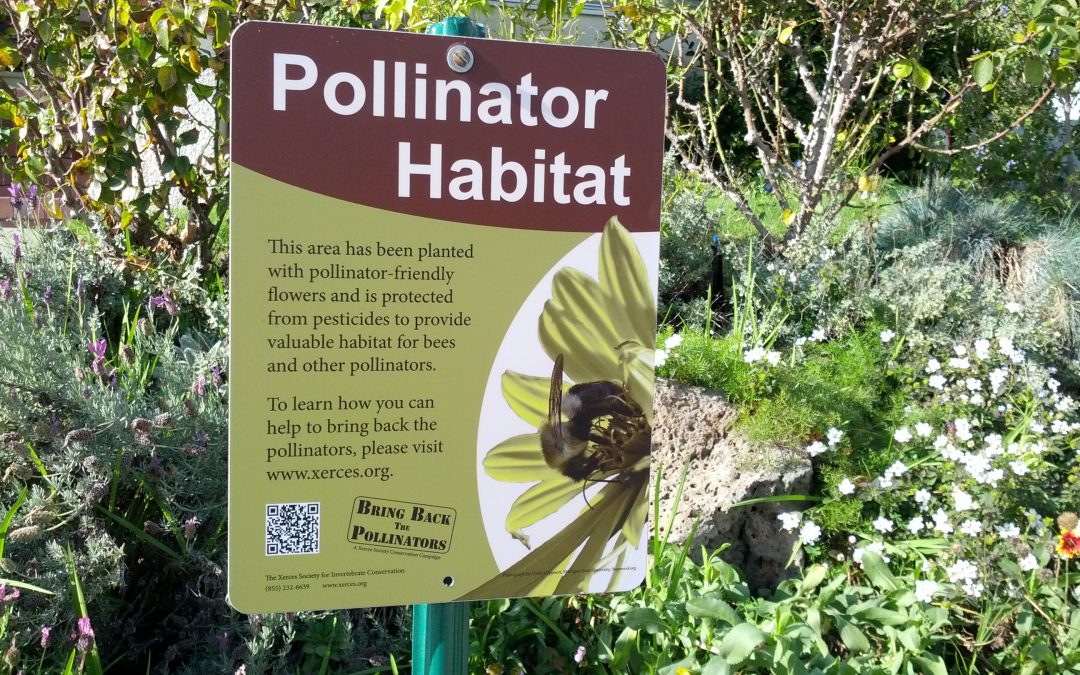Crucial to Our Ecosystems
Pollinator habitats are an indispensable part of our ecosystems and their importance in any farm design cannot be overstated. Eighty percent of the food we eat requires pollinators (and theyʻre requisite habitats) to grow and produce fruit, seeds and vegetables. Ninety percent of flowering plants depend on them for reproduction, as well as a third of human food crops.
Pollinator habitats also provide homes to many tiny insects which are the foundations of ecosystem health. The combined mass of insects worldwide actually exceeds that of any other animal group by an order of magnitude—even as they have, sadly, drastically declined over the past two decades. (Have you noticed less dead bugs on your windshield?)
Creating pollinator habitats is also important in restoring the great losses of these ecosystems in Hawai’i—especially due to coastal development. The shift from native forests to exotic, non-native forests has also exacerbated the loss of pollinator habitats. Pollinators also form an integral part of the web of biological diversity that helps sustain our quality of life. It’s more important than ever that we cultivate their homes in service of the health of our biosphere and the future of humankind.
Types of Pollinators
Pollinators include any animal or insect that helps fertilize plants by carrying pollen from the male part of a flower (stamen) to the female part of the same or another flower (stigma). Plants must be fertilized to produce fruits, seeds and young plants. Pollinators include:
- Bees (solitary bees, honey bees, carpenter bees, yellow-faced bees)
- Flies (various species)
- Birds (Hawaiian honeycreeper and ‘Apapane)
- Bats (Hawaiian hoary bats)
Hawai’i is home to more than 40 species of endemic yellow-faced bees (hylaeus), two of which have been recently listed as endangered. In general, pollinators inhabit biomes from coastlines to alpine tundra. Some species of pollinators are very host-specific, meaning they only pollinate certain species of plants. Their presence and survival is often critical for the continued survival of their host plants.
Elements of a Pollinator Habitat
Pollinator habitats require five crucial elements in order to support their inhabitants. These include:
- A place to live
- A place to procreate
- Source of water (critically important)
- Source of nectar (food and sustenance)
- Sources of building material for shelter (hollowed out stems, hollowed out logs, soft wood of plant stems, bare or partially bare soil).
Habitat Creation and Site Selection
A pollinator habitat can be created by a number of methods including:
- Exposing soil;
- Drilling holes into untreated wood (e.g. tree stumps, logs);
- Creating a minimum 10-foot width between plants designated to provide water and nectar for pollinators;
- Using marginal, underutilized land with good sun exposure (e.g. exposed rocky hillsides, along forest edges and property fence lines, roadsides free from herbicide treatment, underneath power lines).
Plant Selection
When selecting plants for a pollinator habitat, it’s important to choose native plants over non-natives because they are locally adapted and consume less water and fertilizer. Native plants also promote biodiversity. It is best to avoid problematic exotic plants as they are not locally adapted and can alter the soil biology.
Plants should ideally be sourced locally from an environment with similar conditions to the pollinator habitat. This could be a neighboring region, or plant nurseries that do not use neonicotinoids which are fatal to insects.
Planting Design
Two different configurations of habitat planting for pollinators will help support a thriving ecosystem:
- Plant diversity: Using plants from different families will yield various shapes of flowers and bloom at different times throughout the year (ideally eight or more species clustered). This will ensure maximum pollination exposure throughout the year.
- Plant uniformity: Clusters of plants that are from the same species and yield a block of colors and nectar-producing plants will attract various pollinators.
Planting using the techniques of direct seeding coupled with transplanting (younger transplants are better to avoid transplant shock) will yield the best results.
Maintenance Guidelines
Weed control of problematic exotic plants is best done mechanically using a lawn mower or silage tarps. Traps suffocate and kill plants over a period of six months. Other weed control alternatives include flame weeding using a propane torch, or applying a solution of 20% horticultural vinegar. Planting short-lived, expansive vines can rapidly cover and shade out non-preferred plants. Types of vines can include squash (planted closely together, three feet apart) and lablab purpureum (planted 10 feet apart).

